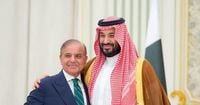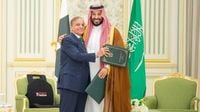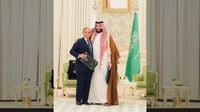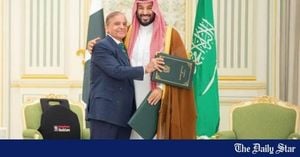On September 17, 2025, a seismic shift rippled through the corridors of power in Riyadh and Islamabad. In a grand ceremony marked by the embrace of two ambitious leaders—Crown Prince Mohammed bin Salman of Saudi Arabia and Prime Minister Shehbaz Sharif of Pakistan—the two nations inked a mutual defence pact that could redraw the security map of the Middle East and South Asia. The ink was barely dry before analysts and diplomats across the globe began to parse its implications, and for good reason: the treaty commits both countries to treat any attack on one as an attack on the other, a clause with potentially explosive consequences in a region already bristling with tension.
The timing is anything but coincidental. Just days earlier, Israel had launched a dramatic airstrike on Qatar, targeting Hamas elements and rattling the nerves of Gulf monarchies. According to ISPI, the attack in Doha served as an “accelerating factor” for the Saudi-Pakistani deal, sending a clear signal to both Tel Aviv and Tehran that Riyadh is no longer content to sit passively under the American security umbrella. Instead, Saudi Arabia is seeking new strategic partners, and in Pakistan, it has found a nation with not only a battle-hardened military but also nuclear weapons—a capability that, while not explicitly mentioned in the agreement, looms large over the region’s strategic calculus.
“Any aggression against either country shall be considered aggression against both,” the pact declares, as reported by Firstpost. This simple statement carries enormous weight, especially when one considers that Pakistan’s nuclear arsenal is estimated at around 170 warheads. For Riyadh, the pact is both a shield and a lever: it bolsters deterrence against Iran and Israel, while signaling to Washington that Saudi Arabia is no longer dependent on American protection alone. The Saudi military, already one of the most advanced in the Gulf—with 283 fighter jets, Terminal High Altitude Area Defence (THAAD) systems, and a growing drone arsenal—now stands to benefit from Pakistani expertise, intelligence sharing, and potentially, the implicit threat of a nuclear umbrella.
But the implications don’t stop at the Gulf’s edge. As ISPI and Firstpost both note, this “geopolitical marriage” also unsettles India, which has spent the last decade carefully cultivating its own partnership with Riyadh. India is Saudi Arabia’s fifth-largest trading partner, with bilateral trade topping $42 billion in 2024-25, and the two countries have collaborated on energy, infrastructure, and even joint military exercises. Yet, as New Delhi’s Ministry of External Affairs made clear, the new defence pact has prompted a period of “cautious study,” with Indian officials vowing to “safeguard national security interests.”
For India, the Saudi-Pakistan axis is more than a diplomatic headache—it’s a strategic complication. The agreement could embolden Islamabad in its long-standing rivalry with New Delhi, and some Indian analysts worry it may push Saudi Arabia further from India’s orbit. There are economic counterweights, of course: as ISPI points out, Saudi-Indian trade dwarfs that between Riyadh and Islamabad, which hovers around $3–4 billion annually. Yet, economic heft can only do so much to offset the psychological impact of Riyadh formally binding itself to Islamabad, especially when nuclear weapons are in the background.
There’s also a domino effect at play. The pact, as described by ISPI, “pushes the United States further from the Western Indian Ocean while pulling China somewhat closer.” For decades, Washington has been the Gulf’s security guarantor, but with American influence waning and China deepening its economic and strategic footprint, the Saudi-Pakistan deal could accelerate a broader realignment. The agreement encompasses not just mutual defence, but also collaboration in defence industry, technology transfer, military co-production, and capacity-building—elements that align with Crown Prince Mohammed bin Salman’s vision of a more autonomous, high-tech Saudi military.
Pakistan, meanwhile, stands to gain both prestige and much-needed financial support. According to ISPI, Saudi Arabia is set to become Pakistan’s largest external financier in 2025-26, with over $6 billion in loans and deposits. This lifeline comes at a critical moment for Islamabad, which faces economic headwinds and diplomatic pressure over its nuclear doctrine and missile program. Yet, as Firstpost cautions, the risks are real: “Pakistan, in the final analysis, cannot sacrifice Karachi for Jeddah.” While the pact may extend a nuclear umbrella over Saudi Arabia, Islamabad’s doctrine still prioritizes threats from India, and it remains unclear whether Pakistan would risk nuclear confrontation with Israel or Iran on Riyadh’s behalf.
For Saudi Arabia, the deal is part of a broader strategy to hedge its bets. Years of seeking stronger security guarantees from Washington have produced little, and the kingdom’s request for F-35 fighter jets remains unfulfilled. The pact with Pakistan is thus as much about reducing dependence on the US as it is about deterring immediate threats. Yet, as Firstpost observes, “nuclear umbrellas are notoriously leak-prone,” and the kingdom may discover the limits of its new alliance if push comes to shove.
The regional repercussions are already apparent. The agreement complicates Saudi Arabia’s efforts to maintain a delicate balance between Iran and the Gulf Cooperation Council, especially as Tehran seeks to rebuild political dialogue with its Arab neighbors. At the same time, it casts a shadow over the India-Middle East-Europe Economic Corridor (IMEC), an ambitious project launched at the 2023 G20 Summit in New Delhi. With Saudi Arabia now more closely aligned with Pakistan, political trust between Riyadh and New Delhi may be harder to sustain, threatening the corridor’s viability as a counterweight to China’s Belt and Road Initiative.
And then there’s the specter of new alliances. As ISPI notes, the Saudi-Pakistan pact could “indirectly push India and Israel into even closer strategic alignment.” Both countries already share intelligence and advanced weapons cooperation, but the emergence of a formal Saudi-Pakistani axis may accelerate their partnership, creating a counterbalance that stretches from South Asia to the Eastern Mediterranean. The result could be a web of interlocking security commitments reminiscent of the alliance systems that preceded World War I—an unsettling prospect in a region where local conflicts can quickly spiral into global crises.
For now, the dust has yet to settle. The Saudi-Pakistan mutual defence pact is as much a product of regional anxieties as it is a catalyst for new ones. It reflects a world in flux, where old certainties are crumbling and new alignments are taking shape. Whether this bold gamble will bring greater security or sow the seeds of future instability remains to be seen, but one thing is clear: the geopolitics of the Gulf and South Asia will never be the same.






